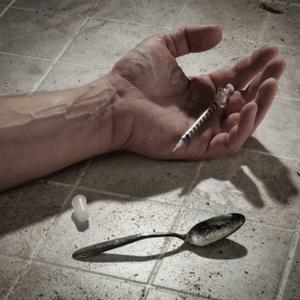
Heroin is primarily produced in Colombia, Mexico, Southeast Asia (especially Burma), and Afghanistan. Depending on how it is processed, it ranges from a thick sticky "black tar" to a brown, tan, or white powder. Street material varies greatly in potency from as high as 95% purity to as low as 5 or 10% purity. Heroin is most commonly injected (intravenously, intramuscularly, or subcutaneously), smoked, or insufflated (snorted).
Dose
Dose depends greatly on the purity of the heroin and level of tolerance. Common intravenous doses generally fall between 5 and 10mg; smoked heroin doses may range from 15 to 25mg. Heroin users typically use small quantities of new material to determine potency and reduce the risk of overdose.
Chemistry
The chemical name for heroin is diacetylmorphine (C21H23NO5). It is a semi-synthetic opiate made by extracting morphine from the opium produced by opium poppies and then acetylating the morphine into diacetylmorphine (heroin).
Pharmacology
Heroin itself is believed to be inactive, but after administration it is rapidly metabolised into the mu-opioid agonists 6-monoacetylmorphine and morphine. Heroin delivers a more intense "rush" and more potent analgesia than morphine, probably because it crosses the blood-brain barrier more rapidly. It is also more soluble in water than morphine, and forms a more concentrated solution. Smoking yields rapid delivery, but relatively low bioavailability as a considerable amount of the drug is destroyed in combustion.
History
Opiates have been used for thousands of years for their euphoric and analgesic effects. Heroin was first synthesised in 1874 by English chemist C.R. Wright. But its commercial value was first recognised in 1897 by Heinrich Dreser and Felix Hoffman at the Bayer pharmaceutical laboratory – the same researchers who invented aspirin, which is is made by a similar process. Heroin was intended to be a less-addictive substitute for other common opiates.
In the late nineteenth and early twentieth centuries, heroin was common in over-the-counter medicines. In the second half of the twentieth century, heroin was widely stigmatized as the quintessential illicit drug, as images of urban heroin addicts were propagated by media reports.
Terminology / Slang
The Substance: Heroin, Dope, Smack, Junk, Horse, H, Chiva
The Experience: No common terms known
Effects
The effects of heroin vary greatly depending on the quality of material, route of administration, the person, and the dose. Possible effects may include feelings of euphoria and well-being, relaxation, sedation, and analgesia. Negative effects may include nausea or vomiting (sometimes severe), constipation, dizziness, and blackout.
Onset
Intravenous injection can produce strong effects in as little as three to five seconds. Smoking produces milder effects within five to 15 seconds. Intramuscular and subcutaneous injection produce a more gradual onset in five to 10 minutes. Insufflated heroin produces effects within two to 10 minutes. Oral use can take 60-90 minutes to produce effects.
Duration
When injected intravenously, smoked, or insufflated, heroin produces a wash of euphoria followed by a period of sedation lasting for two to four hours. Intramuscular and subcutaneous injection typically lack the initial wave of intense euphoria, and cause feelings of sedation lasting three to five hours.
Problems
Heroin use can cause death by respiratory failure. Several factors can increase the risk of overdose, including the strong tolerance effects that develop with repeated use. Tolerance effects wear off over time, and users who take a break may find that a previously-safe dose is now dangerously large. The purity of street heroin is also highly variable (and may have risen in recent years) and users often do not know how much heroin they are taking.
Street heroin is frequently impure, and some adulterants are dangerous. Several hundred heroin users died in 2006 in the U.S. after unwittingly taking heroin cut with fentanyl, a powerful synthetic opiate.
Repeatedly snorting heroin can cause severe damage to the nose, especially with long-term exposure. Smoking heroin can cause breathing difficulties.
Contraindications
Do not operate heavy machinery. Do not drive.
Heavy or frequent opiate use during pregnancy may cause dependence in the foetus, who may undergo withdrawal after birth. It has also been associated with lower birth weight and increased infant mortality.
Addiction potential
One of the most problematic aspects of heroin is that it causes rapid tolerance and physical dependence. In combination with its euphoric effects, this leads many people to become addicted, having difficulty controlling their own use. Once physically dependent, discontinuation generally causes extremely unpleasant (but not life-threatening) withdrawal symptoms such as nausea, vomiting, insomnia, diarrhoea, and sweating.
- Article used with the permission of Erowid.org. Last modified April 2009.
Erowid caution and disclaimer
This Erowid article is a summary of data gathered from Erowid site visitors, government documents, books, websites, and other resources. As this field is complex and constantly changing, information should always be verified through additional sources.




 Publications
Publications
 Partners
Partners









